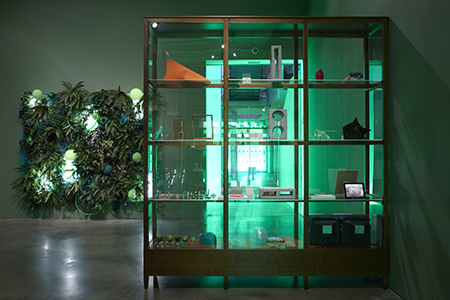Melanie Smith
MK Gallery, Milton Keynes, UK
MK Gallery, Milton Keynes, UK

The alliterative rhythm of the idea – Melanie Smith from Mexico City in Milton Keynes; it could almost be a line from Dr. Seuss – feels apt for an artist with such an impish sensibility. Born in England in 1965, Melanie Smith moved to Mexico in 1989 after training as a painter at the University of Reading. In the early 1990s she turned her flat into Mel’s Café, a weekend ‘pop-up kitchen’ where artists including Francis Alÿs and Gabriel Orozco would play cards and exhibit work. Smith has since become a cornerstone of the artistic community in Mexico and represented the country at the 2011 Venice Biennale, making her first UK survey exhibition, at MK Gallery, a welcome, if overdue, homecoming.
The opening gallery established a parallel between two seemingly disparate places: Spiral City (2002), a five-minute aerial portrait of Mexico City’s sprawling urban grid (a response to Robert Smithson’s Spiral Jetty, 1970), was projected on a vast scale opposite Six Paintings of Urban Views (2006), a series of modest canvases on which similar scenes are abstracted beneath a milky film of acrylic paint. The wash of greys within the gallery was offset by pools of verdant light from tinted windows in the foyer and corridors. This encouraged the mind to leap from Mexico’s capital – a concrete jungle at the heart of a subtropical country – to Milton Keynes – a suburban grid designed to incorporate green space and lush planting, according to the Garden City ideals that inspired the so-called New Towns of post-war Britain.
This play with colour developed in the adjoining Cube Gallery where the two most substantial works in the exhibition were screened in rotation. As ever with Smith, much was expressed at first through form: the darkened room contained a horizontal screen at right-angles with a vertical one; a portrait and a landscape then, each accompanied by cushioned chairs that encouraged you to stay for the duration. Xilitla (2010), perhaps the artist’s best-known work, relates to ‘Las Pozas’, the Mexican garden that belonged to the eccentric British poet-turned-art-collector Edward James, who began constructing surrealist concrete follies (with names like ‘The House With a Roof Like a Whale’) after a frost killed his orchid collection in 1962. Smith’s 12-minute, 35mm film sensually evokes the ruins of this Edenic kingdom; the awkward cuts and disjunctive sound (including whispers, footsteps and an extract from the shipping forecast) draw attention to the seductive allure of the image of triumphant nature. As Dawn Ades astutely remarked in conversation with the artist, this recurrent theme in Smith’s work mirrors a surrealist vision well summed up by the title of a 1937 article by Benjamin Péret in the journal Minotaure: ‘Nature Devours Progress and Surpasses It’.
If Fordlandia (2014), Smith’s latest film (commissioned by MK Gallery) differs in tone from her earlier work, it is perhaps because there have been two crucial shifts in her recent practice: she no longer works with Rafael Ortega (the artist and cameraman who has also collaborated extensively with Alÿs) and she has adopted HD video. The latter was partly necessitated by the remoteness of her new subject: Fordlandia is an abandoned industrial town in the heart of the Brazilian rainforest. It was established by Henry Ford in 1928 in the hope of both cultivating the world’s largest supply of rubber and, at the same time, exporting an idealized vision of suburban America. The project failed dramatically: the imported managers contracted tropical diseases, the rubber trees suffered in tightly-packed plantations, the local workers revolted against Ford’s imposed Puritanism and, in 1945, his grandson, Henry Ford II, was forced to sell the land back to the Brazilian government at a loss of over $20 million. Smith brings to the story the scrutiny of a nature documentary – each elegiac view of rusting machinery is interrupted by an astonishing close-up of a colony of insects or a monkey’s tail dangling from the canopy – but there is no recounting of Ford’s epic failure. The complex Amazonian ecosystem appears to resist the colonizing imposition of narrative order just as it rejected Ford’s naïve utopia.
The final gallery was a slightly crowded attempt to condense the rest of Smith’s career into one room. Six large vitrines, mimicking Victorian cases, reinforced her fascination with artifice. These cabinets housed ‘precious’ paintings and photographs amid plastic trinkets, leaving the viewer to invent their own taxonomy. The earliest work in the show, Orange Lush (1995), is a board cluttered with orange objects, collected when Smith began to notice this synthetic colour littered around Mexico City – the detritus of modernization. The artist has often explained her exquisite eye for detail to be the result of her expatriate ‘outsider’ status. Walking out onto the boulevards of Milton Keynes, I, too, felt displaced, able for a moment to experience my surroundings in their newly-saturated intensity.
























